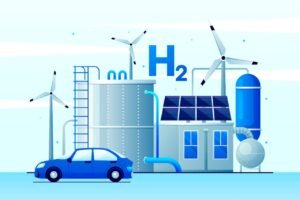
As we move toward clean energy, hydrogen is becoming a strong option. But not all hydrogen is the same. While grey and blue hydrogen are produced using fossil fuels, a green hydrogen system offers something different and promising: a way to create hydrogen without adding carbon to the atmosphere.
Powering green hydrogen production
At its core, a green hydrogen system relies entirely on renewable energy sources, such as solar, wind, or hydropower, to fuel the production process. Unlike grey hydrogen, which emits significant CO₂ during production, green hydrogen is carbon-neutral from start to finish. This is why governments, industries, and energy companies worldwide are prioritizing its development.
The production process begins with water, the simplest and most abundant compound on earth. Through electrolysis, water is split into hydrogen and oxygen gases. The hydrogen can then be stored, transported, and used as a clean energy source in industries, transportation, and even power generation.
Breaking down electrolysis
Electrolysis sits at the heart of every green hydrogen system. In simple terms, it’s a chemical process that uses electricity to split water molecules (H₂O) into hydrogen (H₂) and oxygen (O₂). The efficiency of this process directly impacts the cost and scalability of green hydrogen. Two main types of electrolyzers (both crucial in scaling production and making green hydrogen economically viable) are widely used today:
- Proton Exchange Membrane (PEM) electrolyzers – compact, efficient, and well-suited for pairing with fluctuating renewable energy sources like solar and wind.
- Alkaline electrolyzers – less expensive and durable, though generally less efficient. Popular for large-scale projects where costs are key.
Barriers to scaled adoption
While the promise of a green hydrogen system is clear, challenges remain. Producing hydrogen with electrolysis is currently more expensive than conventional fossil-fuel-based methods. Energy losses during the process, combined with the high cost of renewable power, make it difficult to compete with cheaper grey or blue hydrogen.
Another obstacle is infrastructure. Hydrogen is the smallest and lightest molecule, which means it requires specialized pipelines, storage tanks, and transport systems to prevent leaks and ensure safety. And upgrading today’s natural gas systems for hydrogen isn’t always possible, which makes things more complicated.
Hydrogen demand across industries
Even with these challenges, demand for hydrogen (especially green hydrogen) is growing. Industries that are difficult to decarbonize, such as steelmaking, cement, and fertilizer production, view green hydrogen systems as a way to reach net-zero goals.
The transportation sector is also focusing on it. Hydrogen-powered fuel cells can drive trucks, buses, ships, and even airplanes without emitting CO₂. Unlike battery-electric vehicles, hydrogen vehicles offer longer ranges and quicker refueling, making them especially attractive for heavy-duty and long-distance transport.
The power sector is another key player. By storing excess energy from wind and solar in the form of hydrogen, utilities can smooth out supply fluctuations and ensure a steady energy flow. This makes green hydrogen a valuable complement to renewable energy expansion.
What’s in the store?
The future of green hydrogen relies on a combination of innovation, investment, and supportive policies. It’s worth noting that better electrolyzer technology should cut costs a lot, while big projects by leading companies and government support are helping progress happen faster.
Spain’s Iberdrola, for instance, is building one of Europe’s largest green hydrogen plants to produce ammonia for fertilizers, while the U.S. Department of Energy’s HyBlend initiative is researching how hydrogen can safely integrate into natural gas pipelines. These efforts highlight how global collaboration is essentially driving momentum.
The takeaway
A green hydrogen system is a pathway to a cleaner, more resilient energy future. By using renewable energy to produce hydrogen without carbon emissions, it offers solutions for some of the toughest challenges in decarbonization.
The road ahead won’t be simple, but with ongoing innovation, strategic investment, and supportive policies, green hydrogen is likely to play a vital role in reshaping global energy systems.
Source: FG Newswire